

LA launches Open Bookshelf, a Collection of Free Ebooks. Listly - Create lists of the things you want. Share them with the people you love. Some Rules We Need to Break In Our Reading Classrooms. We seem to be run by the rules of what came before us.
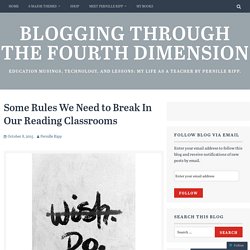
We seem to be trying to uphold traditions that were started all in the spirit of becoming better reading teachers. Technology, libraries, and schools. What Does the Next-Generation School Library Look Like? At a time when public libraries are starting to offer everything from community gardening plots to opportunities to check out humans for conversations, some school libraries are similarly re-evaluating their roles and expanding their offerings.
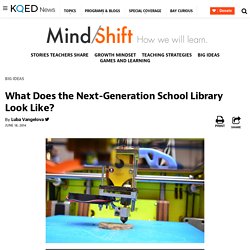
Case in point: Monticello High School in Charlottesville, Virginia. When librarian Joan Ackroyd arrived there four years ago, she found an environment very different from the “engaging, creative, fun” elementary and middle school libraries to which she was accustomed. “Its library was none of those things,” she recalls. “It was a traditional, quiet research space.” Year of the Learning Commons. Learning Commons: the Center of Participatory Learning and School Improvement Continuing their long service to children, teens and teacher, teacher librarians are developing new ways to not only support the consumption of knowledge through great collections in many formats but are encouraging everyone to create knowledge in the new world of information, technology, and the challenges of school improvement.
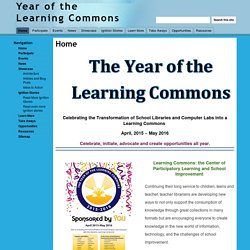
Major changes to traditional school libraries include the reinvention of physical space that meets the needs seeking a physical space that adapts to what they need at any given time. There is space for individuals, small groups and large groups who are using resources, making, building, creating, doing, and enjoying a very busy space that welcomes the use of many forms of technological devices. Digital resources and collaborative learning happens 24/7 in the Virtual Learning Commons Where learners can link to opportunities and work with others across the world. Teacher Librarian Roles. School Libraries. Library Outreach/ LSTA | School Libraries back to top Listserv The South Dakota State Library hosts an email discussion list for school librarians.
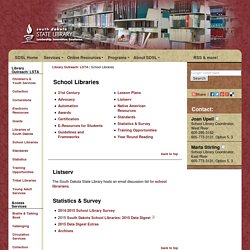
Statistics & Survey 21st Century Students Use 21st Century School Libraries. Sch Lib Collection Development Framework. Access to Resources and Services in the School Library Media Program. The school library plays a unique role in promoting, protecting, and educating about intellectual freedom.

It serves as a point of voluntary access to information and ideas and as a learning laboratory for students as they acquire critical thinking and problem-solving skills needed in a pluralistic society. Although the educational level and program of the school necessarily shape the resources and services of a school library, the principles of the American Library Association’s Library Bill of Rights apply equally to all libraries, including school libraries. Under these principles, all students have equitable access to library facilities, resources, and instructional programs.
Code of Ethics of the American Library Association. Position Statement on Labeling Books with Reading Levels. The following position statement is currently under review to align with the National School Library Standards.
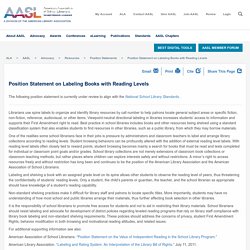
Librarians use spine labels to organize and identify library resources by call number to help patrons locate general subject areas or specific fiction, non-fiction, reference, audiovisual, or other items. Leveling and Labeling: An Interview with Pat Scales. As school districts across the country continue to adopt leveled reading programs like Accelerated Reader, school and public libraries are under increasing pressure to label library materials with leveling information.
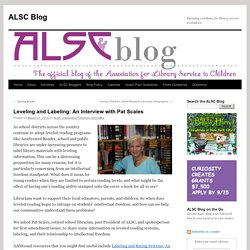
This can be a distressing proposition for many reasons, but it is particularly concerning from an intellectual freedom standpoint. What does it mean for young readers when they are limited to certain reading levels, and what might be the effect of having one’s reading ability stamped onto the cover a book for all to see? Librarians want to support their local educators, parents, and children. School Library Collection Development. Resources for School Librarians - Index "It does not matter how many books you may have, but whether they are good or not.
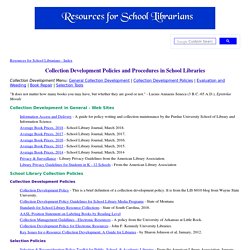
" - Lucius Annaeus Seneca (3 B.C.-65 A.D.), Epistolae Morale. Real Makerspaces in School Libraries. Are makerspaces flashy trends or core to our mandate?
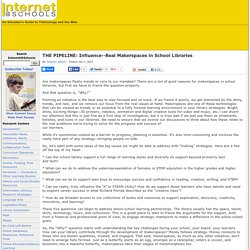
There are a ton of good reasons for makerspaces in school libraries, but first we have to frame the question properly. And that question is, “Why?” Framing an initiative is the best way to stay focused and on track. If we frame it poorly, we get distracted by the shiny, trendy, and new, and we remove our focus from the real issues at hand. Makerspaces are one of these technologies that can be viewed as trendy or as essential to a fully formed learning environment in your library strategies.
While it’s sometimes viewed as a barrier to progress, planning is essential. So, let’s start with some ideas of the big issues we might be able to address with “making” strategies. 13 Great Free and Easy Survey / Polls Creation Tools for Teachers. 1- Kwiqpoll This is a simple poll making tool.
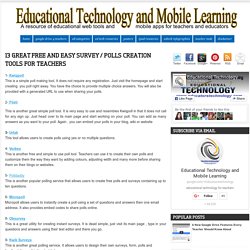
It does not require any registration. Just visit the homepage and start creating you poll right away. To Weed or Not to Weed? Criteria to ensure that your nonfiction collection remains up to date. With a growing emphasis on nonfiction in the curriculum, it’s time to examine what’s sitting on school library shelves. Collection development is more than buying new books. Continuous pruning, updating, and evaluation is required if our libraries are to remain viable resources. Discarding obsolete or damaged material—aka weeding—helps ensure that our collections remain appealing and current. The process also highlights areas where there is room for growth. An up-to-date collection, even if small, is better than one filled with outdated or worn material. CREW Method Devised by the Texas State Library and Archive Commission, the CREW (Continuous Review, Evaluation, & Weeding) Method* involves evaluating books by year of copyright, last use, and condition.
Banned Web Sites: Are Your Policies Up-To-Date? In looking over an assignment to develop a library reconsideration policy that I gave to my graduate students, it occurred to me that an important information element is missing. Every reconsideration policy that I surveyed had the usual slots for challenging books, videos, etc. but almost none had a place for reconsideration of district-blocked Web sites. While it may be true that a district has a procedure in place for calling the IT department to unblock a particular site, what happens when the unblocking is refused or if there is a systematic blocking of sites by the district filtering software? Two examples made me start thinking about this issue.
I use Skype in my library science classes and one of my students said she couldn’t use Skype at school. My Approach To Digital Content Curation. My Approach To Digital Content Curation by Steven Anderson, Presenter at tlipad.com. I spend a great deal of time looking up stuff. A Guide to Blogging and Examples of Classroom Blogs. This morning at the ISLMA Conference I gave a short presentation on blogs and social media for teachers and school leaders. There were a few folks who expressed interest in coming to the session, but weren't able to attend so I promised to post the highlights here. Embedded below you should see my 90 page guide to using Blogger. The guide covers everything from starting your first blog to privacy settings to editing your blog's layout. The guide also includes a glossary of terms frequently used in blogging.
Welcome Home! - Digital Curation - LibGuides at University of South Dakota. Welcome Home! - STEM - LibGuides at University of South Dakota. This guide is designed to better help you understand and explore STEM digital resources, both in the library and at home. The information in this guide has been broken down by age range as a guideline, but feel free to explore all the tabs, as resources are often able to be modified to suit all age ranges. What's STEM? : A quick overview of what STEM is and why it matters.
Tips & Tools: Interactive teaching methods and links to multi-media tools. Early Childhood STEM: Includes links to the basics of STEM instruction and activities for the youngest set. Kids STEM: Resources and activities for exploring science, math, engineering and technology for ages 5-12. Getting to E: The State of the School Ebook Market. Illustration by Ken Orvidas. By fits and starts, school libraries are moving toward ebook adoption; the question is how fast. EdWeb: A professional online community for educators. It's More than Books. Librarian Creates 'Books for Kids in Gay Families' Website Patricia Sarles, MA, MLS has put together an extraordinary resource; a virtual library catalog of books for children related to various LGBTQ issues.
When I discovered that my book, Rumplepimple, had been included in the Books for Kids in Gay Families list I was first thrilled, and then intrigued. I decided to ask her a few questions about how the whole thing came about. Here are her responses. I think you'll find her story fascinating. How did you get started with this effort? I am a librarian and I became interested in children's books on the topic of assisted reproductive technology when a social worker colleague, who is a fertility counselor, asked me if I could find her any books on this topic.